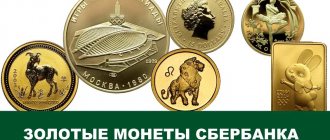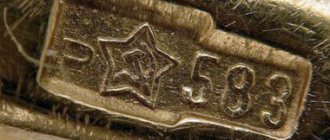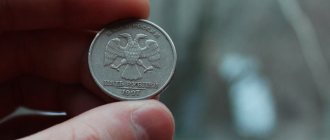Products of Russian refineries
They are classified according to different criteria:
- weight;
- form;
- manufacturer;
- sample or quantitative indicator of the gold content in the product;
- accompanying documents or quality certificates.
Among the most familiar to the average person are measured and standard ones, as well as with branded symbols. Let's talk about them.
Measured
This is the name for ingots produced by Russian or international refineries strictly in accordance with the standard - GOST R 51572-2000:
- 99.9% – pure gold content;
- up to 1,000 g – weight (1, 5, 10, 20, 50, 100, 250, 500 and 1,000 g);
- sizes are different.
Pixabay/HamiltonLeen
They are intended for individuals and are very popular among them. There are many of them on the market: they are sold and bought, presented in banks or jewelry stores. And the more a 999 fine bar weighs, the more expensive it is.
Three different technologies for their production are known:
- Stamped ones marked SSHZ are the most expensive.
- Cast ones, weighing up to a kilogram, with the designation SLZ - are cheaper.
- Powder - do not comply with Russian standards.
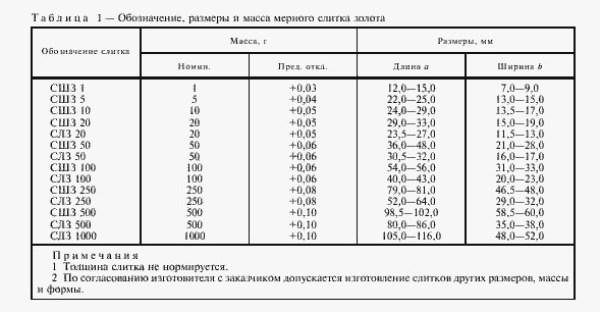
Screenshot GOST R 51572-2000
But not only its designation is applied to the ingot, but also the following information:
- oval stamp “Russia”;
- weight;
- the inscription "Gold";
- try;
- manufacturer's brand.
This is a mandatory requirement of GOST.
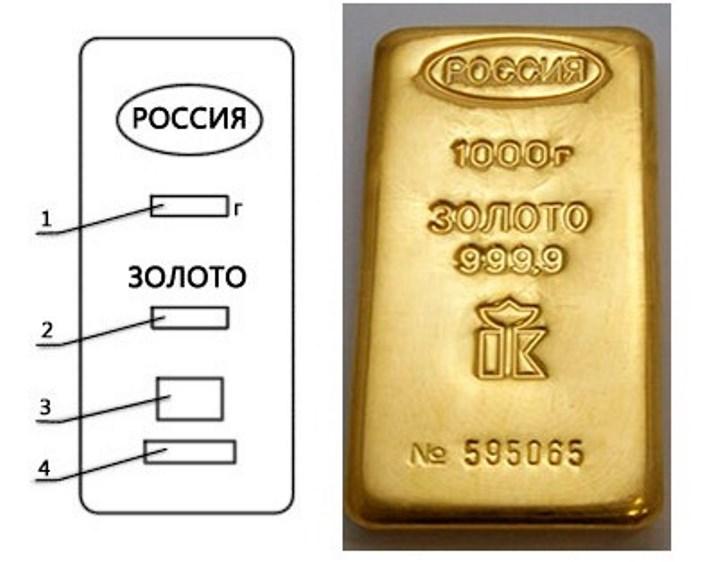
Screen marking of a measuring ingot
But, before information about it is stamped on the product, the sample is tested in the chemical laboratory of the plant. If the gold is not pure enough, it is sent for reprocessing. Without the final approval of the chemists, the ingot will not be branded.
All inscriptions are placed on the title side of the product. They must be legible without corrections or merged letters. The presence of any defect reduces the cost.
Each ingot is accompanied by a manufacturer's certificate (GOST R 51572-2000, clause 4.4.2).
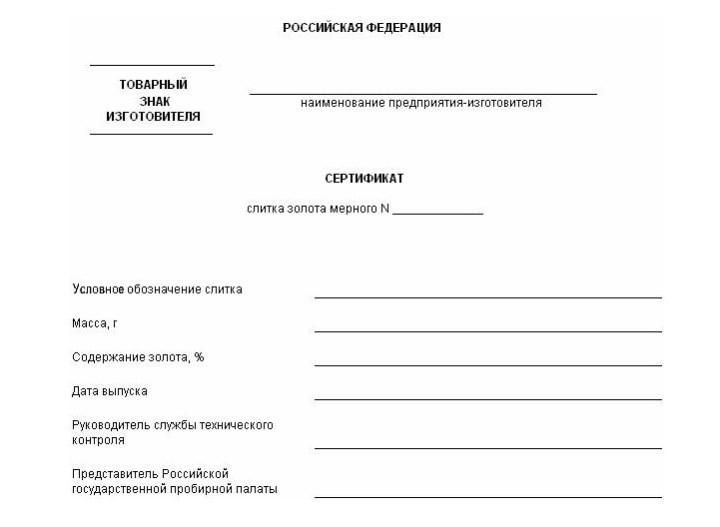
Source: GOST R 51572-2000, Appendix B
Have you ever bought gold bullion?
Yes
No
Standard
They are also produced at refineries and labeled strictly according to state standards. These are banking metal ingots that meet all quality standards and requirements. They are intended to be raw materials for jewelry workshops and factories; they are not used in everyday life. And therefore they do not differ in variety. Such bars contain Russia's gold reserves.
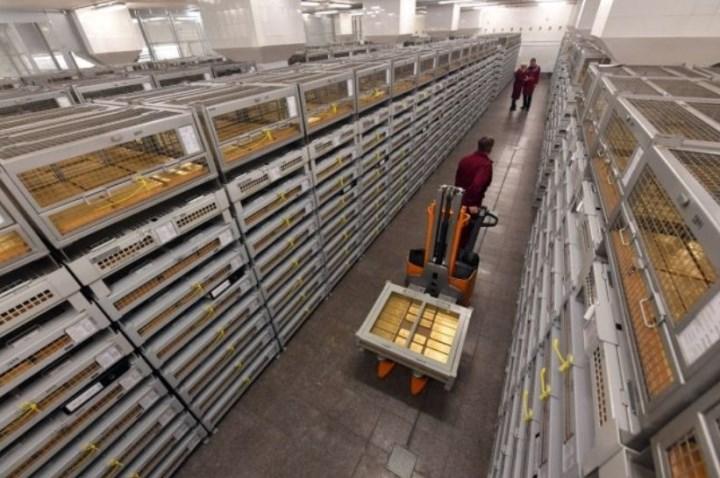
Photo: in the vault of the Central Bank of the Russian Federation
According to Kommersant, at the end of 2021, reserves of precious metals in Russian banks reached a record value of more than 92 tons. This is the maximum over the last 5 years.
Reference! At VTB at the end of the year - 54 tons, Sberbank - 17 tons. At Sovcombank, FC Otkritie, Gazprombank and the National Clearing Center - from 1 to 5 tons.
“Purchases are usually made at the end of the mining season, then the gold is gradually sold to consumers and the Central Bank.
Now it is already less than at the beginning of the year" Sberbank
Requirements for standard products are regulated by GOST 28058-89:
- The mass fraction of gold must be at least 99.99%.
- Shape – regular truncated pyramid with dimensions, mm:
- larger base – length 254±5 and width 88±5;
- smaller base – length 229±5 and width 59±5;
- height – 35±2.
- The weight of a standard gold bar in kg is from 11 to 13.3.
- The surface is free of stains and/or damage.
- The depth of the cleaned areas is no more than 1 mm.
- Concavity – no more than 5 mm.
Markings are applied to the larger side of each copy in accordance with GOST requirements. In addition, it must have a standard certificate, just like a measured gold bar.

Find out all about existing samples of the yellow metal.
With branding
Only very successful companies allow themselves such business gifts to their partners or even employees. A VIP gift can be either a single bar or a whole set. Their weight, in accordance with international standards, varies from 1 g to 1 kg.

Photo: Pixabay/flaart
Interesting! LEGO gives its employees who have worked for the company for 25 years a 25.65 g bar.
Measured and standard ingots

Measured bars (weighing from 1 g to 1000 g) at Sberbank are presented in gold, silver, platinum and palladium. Measured gold bars at Sberbank are presented in all weights defined by standards: 1, 5, 10, 20, 50, 100, 250, 500 and 1000 grams. Small weight silver bars are very rare. Sberbank sells silver in measured bars weighing 50, 100, 250, 500 and 1000 grams. The most popular are kilogram silver bars. Platinum and palladium in metered bars are available for sale in the form of bars weighing 5, 10, 20, 50 and 100 grams.
At Sberbank you can also purchase standard bars of gold, silver, platinum and palladium.
We recommend reading: Buying gold bars abroad
Standard precious metal bars are produced by the same refineries only according to different standards that meet international requirements for the refining of precious metals.
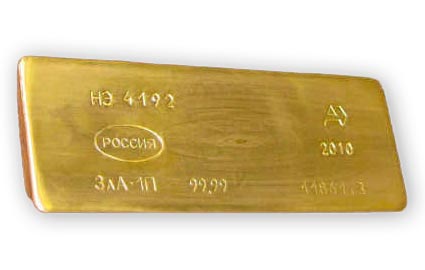
Standard gold bar
Standard ingots differ from measured ones in weight, ingot shape, and markings on the ingot. Thus, the weight of a standard gold bar ranges from 11,000 grams to 13,300 grams, and a silver bar weighs from 28,000 grams to 32,000 grams. For standard platinum bars, the weight is limited to 5500 grams, and for palladium bars - 3500 grams.
Ingots can be cast or stamped according to the production method. Typically, most small-weight gold and silver bars are made by stamping, while large bars are made by casting. Measured ingots of platinum and palladium in all scales are stamped. It is believed that stamped bars are more liquid and slightly more expensive to produce than cast bars. Standard ingots are always produced by casting.
Ingot standards for the whole world
A well-known example of precious metal bullion is the London Good Delivery, which means “safe bet” in English. It has been approved by the LBMA (London Bullion Markets Association) and LPPM (London Palladium and Platinum Market).

Photo: Pixabay/flaart
In the vaults of the central banks of most countries there are classic Good Delivery bars. Their traditional weight is 400 troy ounces, or 12.4 kg. And they are traded in all the main international centers for the sale of this precious metal: London, New York, Zurich, Hong Kong, Sydney and Tokyo.
Table 1. Requirements for 995 gold bars
| Names of standards | Units | Values |
| Weight | t oz | 350-450 |
| G | 10 886-13 754 | |
| Dimensions | mm | |
| length of the larger base | 250 (+/- 40) | |
| width of larger base | 70 (+/- 15) | |
| thickness (height) | 35 (+/- 10) |
Source: inzoloto
Acceptable beam bevels: 7-15% in length, 15-30% in width.
The following is imprinted on the outer surface:
- manufacturer's mark;
- weight;
- purity (sample);
- serial number;
- year of creation.
Ingot as a gift
Gold bar in gift wrapping
When you contact another bank, you can find measuring bars of a different weight. For example, the Russian GOST establishes a weight scale for silver ingots that is similar to gold ingots with the smallest ingot weight of only 1 gram. But in reality, it is almost impossible to find such an ingot on sale, because... from an investment point of view, it is not advisable to buy such bars: its price will be far from the price of a gram of silver, including the costs of production, transportation, bank margin, etc. Small bars are usually purchased as a stylish business gift.
Sberbank offers the purchase of gold and silver bars in branded high-quality packaging. A gold bar as a gift in Sberbank branded packaging can be 1, 5, 10, 20 and 50 grams. The price of a gift bar increases by an average of 280 rubles. Silver in gift cases can be purchased in bars weighing 50, 100, 250 and 500 grams.
We recommend reading: Gold bullion prices in the CIS countries
Standard requirements for palladium ingots
The weight of a palladium bar must be between 32,150 and 192,904 troy ounces (1kg and 6kg). Precious metal with a purity of at least 999.5 purity.
The required elements on a palladium ingot must be:
- serial number of the ingot;
- sample of precious metal;
- precious metal letters – “PD” or “Palladium”;
- ingot manufacturer's mark;
- The weight of the bar is indicated in troy ounces or grams.
The surface of the ingot must be smooth without any damage or burrs.
Standard requirements for platinum bars
The weight of a platinum bar must be between 32.150 and 192.904 troy ounces (1 kg to 6 kg).
The sample must not be lower than 999.5 (999.5 parts of chemically pure platinum per 1000 parts of alloy mass).
Mandatory marking elements on the surface of a platinum ingot:
- serial number of the ingot;
- sample of precious metal;
- precious metal letters – “RT” or “PLATINUM”;
- mark of the ingot manufacturer;
- weight of the ingot (display in both grams and troy ounces is acceptable).
The requirements for the surface condition of the ingot are the same as for silver bars.
Standard requirements for silver bars
The weight of a Good Delivery silver bar must be between 750 and 1,100 troy ounces (23,328 g and 34,214 g). The weight of the bar in troy ounces must be a multiple of 0.10 ounces, otherwise the weight is rounded down to the nearest 0.10 ounces.
The LBMA recommends that manufacturers stick to the weight range of 900 – 1050 troy ounces when producing silver bars. Previously, the standard provided for a wider range of weights for silver bars - from 500 to 1250 troy ounces. Bullion produced before 1 January 2008 in the old wide range of weights is currently eligible for trading on the international bullion market, but it is expected that over time the number of bars in London vaults should drop to zero.
The sample must not be lower than 999.0 (999 parts of chemically pure precious metal per 1000 parts of alloy mass).
The recommended sizes for silver bars are as follows:
- Large base length - 300 mm +/- 50 mm;
- Width of the large base – 130 mm +/- 20 mm;
- Height (thickness) - 80 mm +/- 20 mm;
The standards for bevel are the same as for gold bars.
The following marking elements must be present on the surface of the silver bar:
- serial number of the ingot;
- sample of precious metal;
- manufacturer's mark;
- weight of the bar (it is acceptable to display it in troy ounces and kilograms).
The shape of the ingot must be correct with straight and not sharp edges. The surface of the ingot should not have physical damage, as well as pores, depressions and other imperfections.
We recommend reading: Investments in gold bars from all sides!




